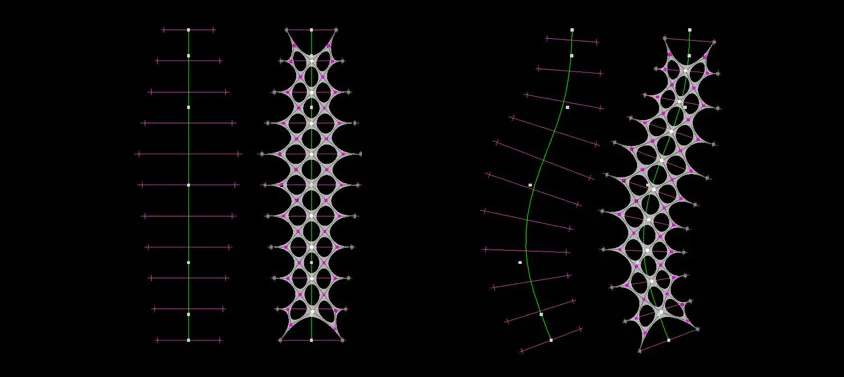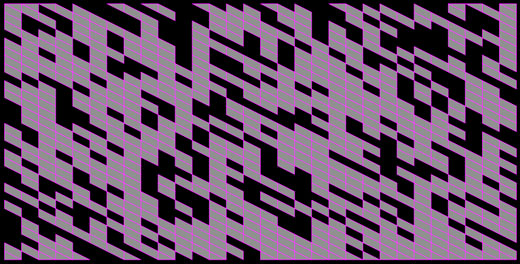This quick animation shows the self optimizing surface I’ve been working on. The clip shows local surface geometry automatically adjusting into the most efficient positions based upon the geometry of the edge control points.
Dynamic Mesh Optimization
This study is something that takes up a number of issues that I’ve been interested in for some time: kinematic armatures, stockings, perforated meshes, and dynamic organization. The goal here is to develop a surface that optimizes its topology to any given form. The diagram above shows a lattice that controls the endpoints of the perforated surface and the resultant surface when these endpoints change position. It is very subtle in the two stages, but the perforations dynamically adjust their shape and position proportionally in respect to assumed material properties in the surface. This is a pretty simple example but the implications of this kind of optimized surface are really profound in my opinion. Not only does this approach solve the seemingly inherent “stopping problem” in dynamically driven architecture, but it provides a new kind of optimized geometry within a given formal organization.
Strata Tower Parametric Model Using Generative Components
PROJECT CREDIT »
Asymptote Architecture: Hani Rashid and Lise Anne Couture
David Farnsworth, the structural engineer we’re working with from Arup New York, won the gold prize at this weekend’s Smart Geometry conference by producing a parametric model of the tower I’m designing at Asymptote. Using Bentley’s Generative Components (beta) he was able to resolve the geometry of the tower’s unique structural system and enable the structure to redistribute itself based on changes to the buildings overall geometry.
Random Selection
60% selection
40% Selection
Maya 8 has a built in random selection tool [ Select > Select Using Constraints > Random ] that works based on the percentage of selectable elements. You can continuously re-select and get some degree of controlled randomization — so cool.
Cutting Polygon Faces
Here is a MEL script I wrote that automates polygon face cutting. Its pretty self explanatory if you’re into this kind of thing. Click here to download.
Bloom 2.0
Bloom is a MEL script that produces variable, three dimensional topologies. By setting these variables to make random selections within a certain range, a sort of snowflake logic arises with intricate micro-scale variation within a coherent macro-scale formal language.
Spiky Shiny
This is an example of a shape made using the bloom MEL script that I wrote recently.
Bloom
This is a form produced using Bloom, a MEL script I’ve been writing that creates blossoming topologies in Maya. Download the Bloom MEL script.
Structural Mesh
I’m working on the design of a parametric structural mesh that uses engineering calculations to drive the design of a surface and then uses the resultant form to re-engineer the structural members. Its a pretty simple concept, when there is a need for more structure, the surface compresses producing a tighter mesh, when there isn’t much force, the mesh becomes looser and the surface expands. I got the idea from looking in the window of Wolford on my way to work and seeing the mesh of some stockings stretching and getting tighter are they went over the mannequin. The trick is getting the surface to realize exactly how much it needs to deform versus how much it can deform. The analysis creates a feedback loop the cycles through the structural data and the surface until the form settles on the best balance between structural and design performance.
Find the Closest Object
This is a useful MEL Script I just finished that Finds the Closest Object to any existing object in 3d space. Click on the link to download.
Calculate Distance
Here is a short MEL script that Calculates Distance between two objects in space. Click the link to download.
Perforated Surfaces
This is basic, but useful. While messing around in Maya, I kind of reverse engineered the manner that subdivisions can be attached to one another to create larger more complex topologies. By using the principles for aggregation in reverse, this technique allows you to create geometrically resolved perforated surfaces. The above image shows a simple case: Create a polygon surface, extrude all the faces in plane but with an offset, delete the new faces, and convert to a subdivision surface. This can be done selectively or in more complex scenarios to produce topologically singular perforated surfaces.








